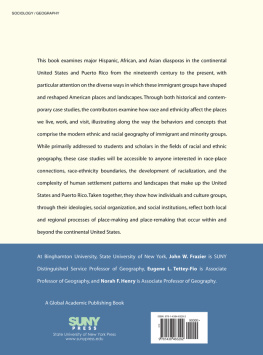
Minority Group Profiles in Strangers to These Shores, Tenth Edition
Amish Americans 408
Arab Americans 279
Asian Indian Americans 255
Australian Aborigines 199
Cape Verdean Americans 339
Catholic Americans 390
Chinese Americans 234
Columbian Americans 376
Cuban Americans 369
Disabled 467
Dominican Americans 373
Dutch Americans 125
Egyptian Americans 289
Elderly 475
Filipino Americans 249
French Americans 127
Gays 458
German Americans 129
Greek Americans 175
Haitian Americans 336
Hawaiians 190
Hindu Americans 416
Hungarian Americans 170
Iranian Americans 235
Iraqi Americans 293
Irish Americans 133
Israeli Americans 295
Italian Americans 171
Jamaican Americans 337
Japanese Americans 242
Jewish Americans 393
Korean Americans 253
Lebanese and Syrian Americans 285
Mexican Americans 359
Mormon Americans 400
Muslim Americans 403
Native Americans 187
Nicaraguan Americans 375
Nigerian Americans 339
Pakistani Americans 261
Palestinian Americans 292
Polish Americans 161
Puerto Rican Americans 364
Rastafarian Americans 411
Romani Americans 178
Russian Americans 164
Salvadoran Americans 375
Santeran Americans 414
Scandinavian Americans 139
Slavic Americans 159
Turkish Americans 297
Ukrainian Americans 167
Vietnamese Americans 261
Women 429







Strangers to These Shores
Race and Ethnic Relations in the United States
Eleventh Edition
Vincent N. Parrillo
William Paterson University
BostonColumbusIndianapolisNew YorkSan FranciscoUpper Saddle River AmsterdamCape TownDubaiLondonMadridMilanMunichParisMontralToronto DelhiMexico CitySo PauloSydneyHong KongSeoulSingaporeTaipeiTokyo
Editor in Chief: Dickson Musslewhite
Publisher: Charlyce Jones Owen
Editorial Program Manager: Beverly Fong
Editorial Assistant: Maureen Diana
Director of Marketing: Brandy Dawson
Senior Marketing Manager: Maureen Prado Roberts
Marketing Assistant: Karen Tanico
Senior Managing Editor: Ann Marie McCarthy
Production Project Manager: Fran Russello
Manufacturing Manager: Mary Fischer
Operations Specialist: Diane Pairano
Art Director, Interior: Anne Bonanno Nieglos
Manager, Visual Research: Martha Shethar
Cover Art: Design Pics/Alamy
Media Director: Brian Hyland
Lead Media Project Manager: Alison Lorber
Full-Service Project Management: George Jacob / Integra
Composition: Integra Software Services, Pvt. Ld.
Printer/Binder: Courier Companies, Inc.
Cover Printer: Lehigh Phoenix
Text Font: 10/13, Adobe Caslon Pro
Credits and acknowledgments borrowed from other sources and reproduced, with permission, in this textbook appear on pages 569571.
Copyright 2014, 2011, 2009 by Pearson Education, Inc. All rights reserved. Printed in the United States of America. This publication is protected by Copyright, and permission should be obtained from the publisher prior to any prohibited reproduction, storage in a retrieval system, or transmission in any form or by any means, electronic, mechanical, photocopying, recording, or likewise. To obtain permission(s) to use material from this work, please submit a written request to Pearson Education, Inc., Permissions Department, One Lake Street, Upper Saddle River, New Jersey 07458, or you may fax your request to 201-236-3290.
Library of Congress Cataloging-in-Publication Data
Parrillo, Vincent N.
Strangers to these shores : race and ethnic relations in the United States / Vincent N. Parrillo, William Paterson University. Eleventh Edition.
pages cm
ISBN-13: 978-0-205-97040-7
ISBN-10: 0-205-97040-0
1.United StatesRace relations.2.United StatesEthnic relations.I.Title.
E184.A1P33 2014
305.800973dc23
2013011273
10987654321
Student Edition:
ISBN 10: 0-205-97040-0
ISBN 13: 978-0-205-97040-7
Instructors Review Copy:
ISBN 10: 0-205-97041-9
ISBN 13: 978-0-205-97041-4
a la carte Edition:
ISBN 10: 0-205-99512-8
ISBN 13: 978-0-205-99512-7

To my Italian-American father and to my Irish/German-American mother
Brief Contents
Contents
Features
Foreword
Americans spend a lot of time thinking about race. Yet we often have a hard time talking about it. The subject is fraught, complicated, and deeply emotional. We worry that whatever we say may cause offense or perhaps betray a bias we know is inappropriate to express. Part of the problem is that the concept is hard to define. Race, social scientists tell us, is more a social construction than a biological reality. As the sociologist Ruben Rumbaut likes to say, it is a pigment of our imagination. Yet the fact that race is to a large degree imaginary does not mean it can simply be imagined away. It is real, because it has real effects on peoples lives.
Ethnicity is even harder to grasp. People often feel they are part of ethnic groups. They sense that ethnic identity is a central part of who they are, something with deep roots that connects them to a long history. Yet a closer examination shows that the content of ethnic identities is constantly in flux and that ethnic boundaries change from time to time and place to place.
In order to have the conversation about race and ethnicity that Americans are so good at avoiding, perhaps the first step is in understanding where these categories come from and where they are going. For anyone ready to take that step, I cannot imagine a better starting place than this book. Simply put, Vincent Parrillos Strangers to These Shores is the best textbook on race and ethnicity currently on the market, as well as one of the best introductions to the topic for the general reader.
The book stands out in a number of ways. First, it is wonderfully written. It avoids clichs and presents complex and controversial material in a style that is clear, fresh, and almost totally free of dogma and jargon. In a time of globalization, the book takes a truly global view of its subject. It recognizes that, while race and ethnicity play a distinct role in American life, they also shape the lives of people in countries around the world, and ethnic conflicts and ethnic identities spill over national borders. The book is also timely; by updating it with frequent new editions, Parrillo has kept abreast of the latest in social scientific research, and in this edition he has added the innovative Students Speak boxes, a feature that makes the book even more accessible. Furthermore, his book takes an expansive view of its subject. In the chapters on new ethnic groups, such as the one on Middle Eastern and North African Americans, and in examining the experience of other types of minority (and majority) groups such as Gays and Lesbians and women, the book broadens our view of who the stranger is. Parrillo shows how ideas that emerged from the struggles for racial and ethnic equality can come to shape the self understandings of very different sorts of social groups. Finally, one of the things I like best about Strangers to These Shores is its historical context. While racial and ethnic identities are often thought of as primordial and unchanging, Parrillo places racial and ethnic groups in their historically specific contexts. In these pages readers will see not only how racial and ethnic groups came to be, but also how they are changing, and how they will no doubt continue to change in the future.
Next page


















